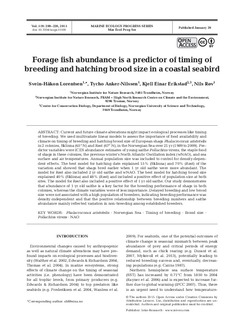Forage fish abundance is a predictor of timing of breeding and hatching brood size in a coastal seabird
Journal article, Peer reviewed
Permanent lenke
http://hdl.handle.net/11250/2396526Utgivelsesdato
2015Metadata
Vis full innførselSamlinger
- Publikasjoner fra CRIStin - NINA [2364]
- Scientific publications [1392]
Sammendrag
Current and future climate alterations might impact ecological processes like timing
of breeding. We used multivariate linear models to assess the importance of food availability and
climate on timing of breeding and hatching brood size of European shags Phalacrocorax aristotelis
in 2 colonies, Sklinna (65° N) and Røst (67° N), in the Norwegian Sea over 21 yr (1989 to 2009). Predictor
variables were ICES abundance estimates of young saithe Pollachius virens, the staple food
of shags in these colonies, the previous winter’s North Atlantic Oscillation index (wNAO), and sea
surface and air temperatures. Annual population size was included to control for density-dependent
effects. The best model for hatching date explained 15% (Sklinna) and 70% (Røst) of the
variation and showed that shags bred earlier when 1 yr old saithe were more abundant. The
model for Røst also included 2 yr old saithe and wNAO. The best model for hatching brood size
explained 40% (Sklinna) and 48% (Røst) and included a positive effect of population size at both
sites. The model for Røst also included a positive effect of 1 yr old saithe. Our study demonstrates
that abundance of 1 yr old saithe is a key factor for the breeding performance of shags in both
colonies, whereas the climate variables were of less importance. Delayed breeding and low brood
size were not associated with a high population of breeders, indicating breeding performance was
density-independent and that the positive relationship between breeding numbers and saithe
abundance mainly reflected variation in non-breeding among established breeders.
KEY WORDS: Phalacrocorax aristotelis · Norwegian Sea · Timing of breeding · Brood size ·
Pollachius virens · NAO

